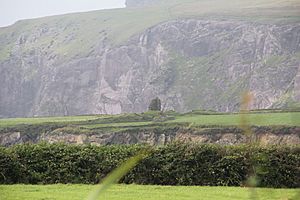Piaras Feiritéar facts for kids
Piaras Feiritéar (also known as Pierce Ferriter) was an important Irish poet and a brave leader. He lived a long time ago, from around 1600 to 1653. Piaras was famous for his many poems written in the Irish language. He is also remembered as a folk hero in the Dingle Peninsula because he led a group called the Irish Confederacy. He fought against the English forces during the Cromwellian conquest of Ireland. Sadly, he was executed in Killarney in 1653 for his resistance.
Contents
Who was Piaras Feiritéar?

Piaras Feiritéar was the last leader of the Clan Feiritéar, a family with Norman roots who had become fully Irish. He was also the Lord of Ballyferriter in a place called Corca Dhuibhne.
Piaras Feiritéar: A Talented Poet and Musician
Piaras was not only a leader but also a very skilled musician who played the harp. He was also a very smart poet who could write in many languages, especially Irish. His poems were known for being a mix of sad songs, praises for people, and funny or critical poems, following an old Irish style called Bardic tradition. He also wrote love poetry that was influenced by ideas from all over Europe.
His most famous poem is called Leig díot t’airm, a mhacoimh mná, which means "Lay aside thy arms, maiden." This poem is about a beautiful woman. Some people think he might have written poems in English too, but none of them have survived. Some experts believe his Irish poems show ideas from English poets of the Elizabethan era.
Piaras Feiritéar: A Brave Warrior
Piaras Feiritéar was an important leader during the wars of the Irish Confederacy. In 1641, he was hurt when Oliver Cromwell's soldiers, called Roundheads, attacked his family's strong castle, Tralee Castle. Piaras and his family members bravely defended the castle. They held out until another important castle, Ross Castle in Killarney, fell to Cromwell's forces in June 1653.
After this, Piaras was offered a safe journey by the Cromwellian commander, Brigadier Nelson, to discuss surrender terms. However, when he arrived at Castlemaine, he was captured. Piaras was then hanged along with others, including his brother-in-law, Tadhg Ó Muircheartaigh, who was a Dominican friar. This happened on Cnocán na gCaorach in Killarney on October 15, 1653.
Piaras Feiritéar's Lasting Impact

Piaras Feiritéar is still seen as a folk hero by Irish-speaking people in the Dingle Peninsula. Especially in his home area of Ard na Caithne, you can still see the ruins of his family's castle. His poetry is still remembered and shared as part of their spoken stories.
How Piaras Feiritéar Inspired Poetry
In 1926, a writer named Daniel Corkery explained that Piaras Feiritéar's death in 1653 helped start a new type of Irish poetry called Aisling. In these poems, a spéirbhean (which means a beautiful, queen-like woman from the Otherworld, representing Ireland) feels sad about Ireland's situation. In later versions of these poems, she even predicts a better future.
Right after Piaras died in 1653, an unknown poet from County Kerry wrote a sad poem about his death. This poem starts with the line, Do chonnac aisling are maidin an lar ghil, meaning "I saw a vision on the morning of the bright day." The vision was of Erin, an ancient Irish goddess, crying over the death of a man who had defeated many enemies.
Stories and Books About Piaras Feiritéar
In his book The Western Island, Robin Flower shared a story told by Seanchai Tomás Ó Criomhthain. Tomás claimed that Piaras had a secret hideout on Great Blasket Island which he used to avoid the authorities.
In 1934, Pádraig Ó Duinnín put together a book called Dánta Phiarais Feiritéir: maille le réamh-rádh agus nótaí. This book contained 23 of Piaras's poems that are still known today. In the book, Ó Duinnín wrote a whole chapter about how Piaras's poetry and life influenced the local stories and traditions.
More recently, in 2001, a poet and writer from Munster named Máire Mhac an tSaoi published a novel called A Bhean Óg Ón.... This award-winning book was about the relationship between Piaras and Meg Russell, who was the inspiration for many of his love poems in the Irish language.
Memorials to Piaras Feiritéar
There is a special memorial for Piaras Feiritéar in Muckross Abbey in Killarney. It stands alongside memorials for three other important Kerry poets from that time. In Killarney town itself, you can see a monument of a spéirbhean (a beautiful woman symbolizing Ireland) with the names of all four poets carved into it.
See also
- Aogán Ó Rathaille
- Dáibhí Ó Bruadair
- Cathal Buí Mac Giolla Gunna
- Peadar Ó Doirnín
- Séamas Dall Mac Cuarta
- Art Mac Cumhaigh
- Seán Clárach Mac Domhnaill
- Eoghan Rua Ó Súilleabháin

